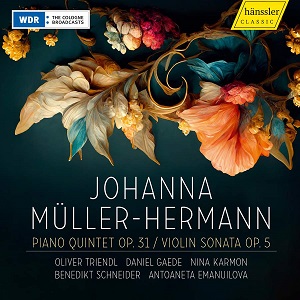
Johanna Müller-Hermann (1868-1941)
Piano Quintet in G minor, Op 31 (1932)
Violin Sonata in D minor, Op 5 (1905)
Daniel Gaede (violin), Nina Karmon (violin 2), Benedikt Schneider (viola), Antoaneta Emanuilova (cello), Oliver Triendl (piano)
rec. 2022, WDR Funkhaus Cologne, Klaus-von-Bismarck-Saal, Germany
Hänssler Classic HC22082 [62]
My previous encounter with the chamber music of Johanna Müller-Hermann was pretty positive (review) as it showed an impressive control of form and expression in her 1908 String Quartet, which was coupled with two quartets by her erstwhile teacher, Zemlinsky. Hänssler has gone one better, devoting a whole disc to her music.
Not only did she come under the guidance of Zemlinsky, but she succeeded another of her teachers, Josef Bohuslav Foerster, as professor at the Vienna Conservatory in 1917. Perhaps someone will exhume her choral works written at around this time. The earlier of the two works here is the Violin Sonata, written in 1905 when she was around 37 years old. It’s a very light-hearted and lyric piece and has a kind of updated Schubertian elegance in its four conventional movements. The piano writing is emollient and supportive and even when the sonata gets a touch more forceful and declamatory it never exceeds the bounds of formal good taste. There’s a smiling cantabile feel to the slow movement and whilst there’s the dreaded fugato in the scherzo it’s not too academic and doesn’t derail the core of the musical argument – though I wish she hadn’t allowed the music to stop dead in its tracks to introduce the B section. A dapper finale – an Allegretto, a little unusually in the context – again evokes the ghost of Schubert.
The bigger and more impressive work is the Piano Quintet of 1932, a product of her full maturity. Once again, it’s in four well-paced movements, but it has far greater expressive breadth than the earlier sonata. It’s pensive for one thing and this opening movement, the longest of the four by some way, contains renewed evidence of her confidence in handling and balancing the instruments and also contains a strong element of turbulent late-Romanticism that reminded me, in places, of Elgar’s Piano Quintet. There are chorale-seeming elements in the gentle, sweetly scented slow movement and pert, crisp folklike elements in the scherzo, along with dancing patterns for the players. The finale opens with a reprise of the earlier unease with which the work had been, a unifying device that sits well, before she unleashes a kind of Lied ohne Worte that takes to the dance with verve, ebullience and robustness.
Leading the dance throughout is the ever-splendid, hard-working Oliver Triendl – people talk about Jenő Jandó’s vast corpus of recordings, but Triendl has his own too – who dovetails finely with Daniel Gaede in the sonata and with the ensemble in the quintet. The notes are to the point and there are no complaints about the always-acceptable WDR recording quality.
If you have an interest in Müller-Hermann and her classical-to-late romantic chamber music, you are in the safest of hands here.
Jonathan Woolf
Help us financially by purchasing from





















